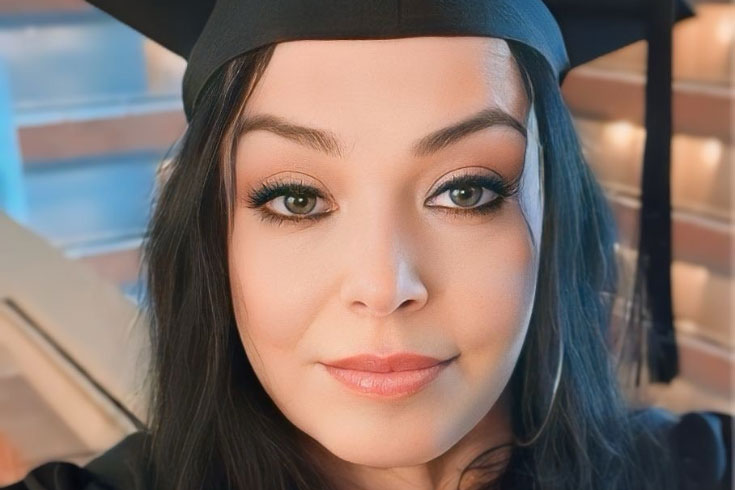Making change, one design at a time
May 21, 2024
 Gabriele Burke MS’24 is using her new user-centered design skills to change mindsets.
Gabriele Burke MS’24 is using her new user-centered design skills to change mindsets.
As someone who grew up and completed her undergraduate degree in Germany, Gabriele Burke MS'24 was nervous about entering the world of U.S. higher education. However, pursuing a master’s degree was always a dream of hers — and after working as a graphic designer in the U.S. for over 15 years, Gabriele felt that she was ready to take the next step in her career.
“I always had my eyes open for something that would complement my previous education,” Gabriele told GPS. “As a graphic designer, I’ve already done a lot of self-learning to keep up with the latest trends, so I knew a master’s in graphic design wouldn’t be helpful to me. After doing some research, I felt that an M.S. in User-Centered Design could really add to my career.”
When researching master’s programs, Gabriele paid careful attention to the values of each institution. “I was looking for a top school, but I was also looking for a school that I could identify with,” Gabriele said. “Brandeis’ origin story inspired me, and I knew I would fit right in.”
As a full-time working professional, Gabriele also knew she needed the flexibility of an online program. Although she was initially apprehensive about the asynchronous learning format, after speaking with an admissions advisor and connecting with a current student, Gabriele felt confident that GPS was the right choice for her: “They showed me the online learning platform and gave me advice on how to navigate the assignment schedule, which helped me tremendously.”
For Gabriele, the shift from graphic design to UX seemed like “a natural progression, because it blends creativity and analytical problem-solving.” However, once she started the program, Gabriele found that she had to adopt “a completely new mindset.”
“As a graphic designer, you’re the one in charge. It’s more subjective, and you make decisions more based on personal taste and experiences,” Gabriele explained. “But with UX, you must consider the user first — and visuals are only a small portion of the process.”
This new perspective has changed the way Gabriele looks at her own work. “Before, I might have engaged in problem-solving subconsciously, but I never knew why I made the choices I did. Now, I’m a lot more aware of the reasoning behind my designs — and I have facts and data to inform each decision I make.”
In addition to gaining a new mindset, Gabriele has also developed new skills over the course of her degree. RUCD 140: Research Methods taught Gabriele that she has a knack for interviewing users, and RUCD 185: Design of Non-Screen User Experiences gave her an invaluable hands-on experience collaborating with peers to create an interactive, self-scan shopping cart.
Now, Gabriele is putting her new knowledge to use in her capstone project — an app called “HadIKnown.” The primary goal of the app is to provide users with information that they should know before making big life decisions, like choosing a career, pursuing a degree, or buying a home. However, during the development process, Gabriele learned that users are looking for more than just useful information — they are also looking for information they can trust.
“When I kept talking to my users and gathering data, I discovered that there’s so much more behind the problem,” Gabriele reflected. “When you give advice online nowadays, there are a lot of trust issues. There needs to be expert verification. So my original idea grew because of my users’ needs.”
This experience has truly solidified Gabriele’s belief in the user-centered design process — so much so that she has already started to implement it at her workplace. “I’ve done heuristic evaluations of websites, and now I’m doing usability testing,” Gabriele says. “But that’s just the beginning. I wholeheartedly, 100,000% believe that the user-centered approach makes better products — so I plan to bring what I’ve learned to our whole team.”
Although Gabriele’s workplace is only in the “emerging” stage of UX maturity, she says that everyone is “super interested” and excited about the changes taking place. “I’m starting to notice little things around me, like how people are using different lingo, and I feel responsible for this. Now we talk about design systems. We talk about users. We talk about use cases. And I feel a little bit responsible for that.”
While these shifts in language may seem small, they mark a huge step towards achieving a more user-centered and inclusive design process — and this step would not have been possible without Gabriele’s GPS degree.
Although balancing a full-time job while earning her degree was no easy feat, Gabriele is incredibly grateful for her time at GPS. “Not only have I been able to apply UX principles directly to my projects, but the learnings have also … open[ed] new avenues for creativity, problem-solving, and career satisfaction.”
She encourages all current and prospective students to “embrace the opportunities for growth and development that such an educational path offers.” This means attending office hours with your instructor — “even if you don’t have a million questions” — and reaching out to your peers, who can be an excellent source of support.
Ultimately, Gabriele says that her “journey from graphic design to UX design through the GPS program has been transformative.” Now that she has graduated with her degree, Gabriele will continue to use her new knowledge and skills to transform her workplace as well.
To learn more about the MS in User-Centered Design and other degrees offered by Brandeis Online, please visit our website.